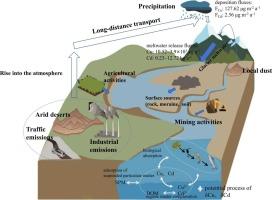Composition, Distribution and Migration Processes of Cu-Cd in Various Environmental Media of the Glacial Watersheds in Tibetan Plateau
IF 11.3
1区 环境科学与生态学
Q1 ENGINEERING, ENVIRONMENTAL
引用次数: 0
Abstract
The Tibetan Plateau (TP), known as the “Water Tower of Asia”, is the source of many major rivers in Asia and an important ecological security barrier in western China. It’s environmental sensitivity and unique high-altitude conditions make researching heavy metals critical. Copper (Cu) and Cadmium (Cd), as typical potentially toxic heavy elements, significantly influence biogeochemical processes in watershed ecosystems. This study systematically summarizes the composition, distribution, and enrichment characteristics of Cu and Cd in snow/cryoconite, soil, and river water within the TP. The results indicate that Cu-Cd in snow/cryoconite on TP shows moderate to heavy enrichments, which is mainly affected by local inputs and long-range pollutants via atmospheric circulation. Besides, the concentration and distribution patterns of Cu-Cd in river water of glacial watersheds varied considerably across regions, with both elements exhibiting notable enrichment. The Yarlung Zangbo River in particular, exhibited obvious impacts from anthropogenic activities. Moreover, the estimated atmospheric wet deposition fluxes of Cu and Cd in the glaciers of the TP are 127.62 μg m⁻² a⁻¹ and 2.56 μg m⁻² a⁻¹, respectively; while the corresponding release fluxes from glacial meltwater runoff are 10.52 ~ 3.9 × 10³ kg a⁻¹ for Cu and 0.23 ~ 12.72 kg a⁻¹ for Cd. The Cu-Cd concentrations in the topsoils of the TP were unevenly distributed, with higher value in the east and lower in the west. The sources of heavy metals were complex and influenced by multiple factors, and the risk of Cd pollution in soil is widespread. Finally, we present a conceptual model illustrating the multi-source origins and migration dynamics of Cu and Cd in the glacial basins. While the TP is generally less polluted than many other global regions, Cu-Cd in glacial environments shows evident anthropogenic influence and elevated enrichment levels, potentially endangering downstream oasis ecosystems and human populations under the pressure of intensified glacier ablation.

它的环境敏感性和独特的高海拔条件使得研究重金属变得至关重要。铜(Cu)和镉(Cd)是典型的潜在毒性重元素,对流域生态系统的生物地球化学过程具有重要影响。本研究系统总结了青藏高原积雪/冻土、土壤和河水中Cu和Cd的组成、分布和富集特征。结果表明:TP上的雪/冰晶中Cu-Cd呈现中~重度富集,主要受局地输入和大气环流中长距离污染物的影响。此外,冰川流域河水中Cu-Cd的浓度和分布格局在不同地区差异较大,两者均表现出显著的富集。人类活动对雅鲁藏布江的影响尤为明显。此外,TP冰川中Cu和Cd的大气湿沉降通量分别为127.62 μ m⁻²a⁻¹和2.56 μ m⁻²a⁻¹;冰川融水径流对应的Cu和Cd释放通量分别为10.52 ~ 3.9 × 10³kg a⁻¹和0.23 ~ 12.72 kg a⁻¹。TP表层土壤Cu-Cd浓度分布不均匀,呈东高西低的趋势。土壤重金属来源复杂,受多种因素影响,镉污染风险普遍存在。最后,我们提出了一个冰川盆地中Cu和Cd多源成因和迁移动力学的概念模型。虽然青藏高原总体污染程度低于全球许多其他地区,但冰川环境中的Cu-Cd表现出明显的人为影响和富集水平升高,在冰川消融加剧的压力下,可能危及下游绿洲生态系统和人类种群。
本文章由计算机程序翻译,如有差异,请以英文原文为准。
求助全文
约1分钟内获得全文
求助全文
来源期刊

Journal of Hazardous Materials
工程技术-工程:环境
CiteScore
25.40
自引率
5.90%
发文量
3059
审稿时长
58 days
期刊介绍:
The Journal of Hazardous Materials serves as a global platform for promoting cutting-edge research in the field of Environmental Science and Engineering. Our publication features a wide range of articles, including full-length research papers, review articles, and perspectives, with the aim of enhancing our understanding of the dangers and risks associated with various materials concerning public health and the environment. It is important to note that the term "environmental contaminants" refers specifically to substances that pose hazardous effects through contamination, while excluding those that do not have such impacts on the environment or human health. Moreover, we emphasize the distinction between wastes and hazardous materials in order to provide further clarity on the scope of the journal. We have a keen interest in exploring specific compounds and microbial agents that have adverse effects on the environment.
 求助内容:
求助内容: 应助结果提醒方式:
应助结果提醒方式:


